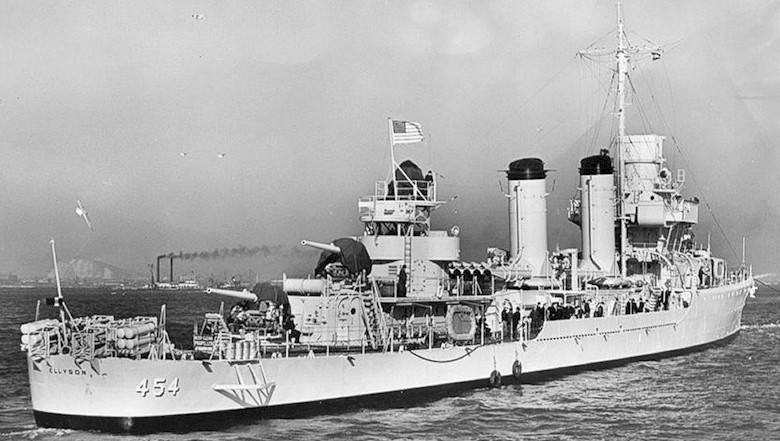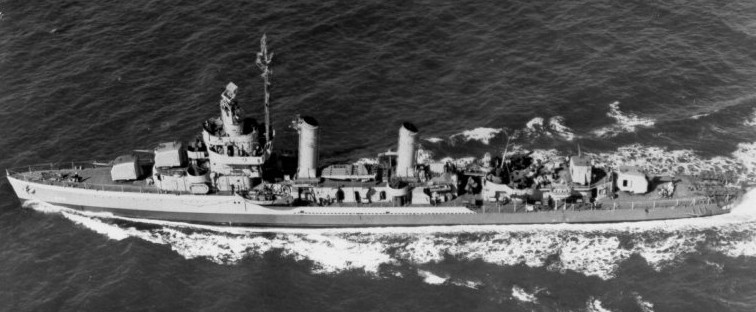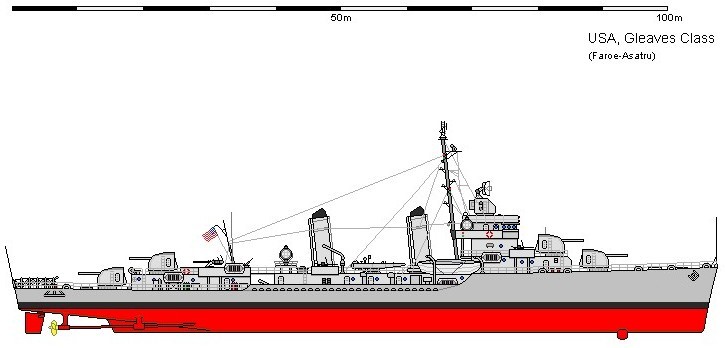|
Asakaze - USS Ellyson (DD 454) - in USN service

USS Ellyson (DD-454):
Theodore Gordon Ellyson, born 27 February 1885 in Richmond,
Va., was the first naval officer designated an aviator. He
served in experimental development of aviation, and
established the Naval Aviation Camp at San Diego in 1911.
Commander Ellyson was awarded the Navy Cross for
distinguished service in World War I, for his development of
successful tactics for the submarine chasers based at
Plymouth, England. He was killed in a plane crash 27
February 1928.
-
Ellyson (DD-454) was launched 25 July 1941 by Federal
Shipbuilding and Dry Dock Co., Kearny, N.J.; sponsored by
Miss Gordon Ellyson, daughter of Commander Ellyson; and
commissioned 28 November 1941, Lieutenant Commander J. B.
Rooney in command.
Still outfitting when the United States entered World War
II, Ellyson was quickly readied for sea and patrolled in the
Atlantic, protecting Allied shipping from Halifax, Nova
Scotia, to the West Indies and Panama Canal. On 14 January
1942 she rescued 24 survivors from the sunken Norwegian SS
Harness. On 15 June she broke the pennant of Commander,
Destroyer Squadron 10, which she was to carry proudly
through the war, through the squadron's redesignation to
Mine Division 20 and the subsequent conversion of its
destroyers to high-speed minesweepers.
In August 1942 Ellyson began operating with Ranger (CV-4),
and remained with her through the landings at Fedhala,
French Morocco, 8 November. After 2 months of escort duty
along the east coast, she rejoined Ranger on two voyages to
Casablanca to ferry Army planes to north Africa.
On 5 April 1943 Ellyson arrived at Argentia to prepare for
operations with the Royal Navy. She sailed for England 12
May in the screen of South Dakota (BB-57) and Alabama
(BB-60), and operated with the British Home Fleet out of
Scapa Flow in the Orkneys screening convoys, giving distant
support to Allied shipping to Murmansk and Iceland, and
attempting to lure Tirpitz and other German surface ships
from the safety of Norwegian bases to battle on the open
seas. In July she took part in a feint invasion of southern
Norway to distract German attention from the real assault on
Sicily.
Returning to Norfolk 9 August 1943, Ellyson screened Iowa
(BB-61) during the battleship's shakedown cruise off
Argentia, then returned to Norfolk with her on 24 October.
On 3 November Ellyson sailed in the scouting line for Iowa
who was carrying President Roosevelt to the Teheran
Conference. Later, moving into the battleship's screen,
Ellyson touched Bahia, Brazil; Freetown, Sierro Leone;
Dakar; and Port Royal, S.C.; before returning to Boston 19
December.
On 6 January 1944 Ellyson once again joined Ranger for
screen and plane guard duty in Narragansett Bay. She sailed
for north Africa 19 April and arrived at Oran 1 May. On the
16th while hunting submarines Ellyson made contact on U-616
touching off an intensive coordinated air-sea hunt. The
submarine surfaced at 2358, and soon dived after a brief
duel with Macomb (DD-458). Ellyson and Hambleton (DD-455)
continued the attack with depth charges, forcing U-616 to
surface again. Ellyson sank her with gunfire on the morning
of the 17th, then rescued 30 survivors.
Ellyson arrived at Plymouth, England, 22 May 1944 for
last-minute preparations for the invasion of France. On 6
June she covered the Ranger's assault on Pointe de Hoc to
knock out the heavy gun emplacements reported there. On 25
June she saw action off Cherbourg, blasting gun
installations, destroying mines, and laying a smoke screen
for larger fleet units.
Ellyson sailed from Portland 29 June 1944, to invade
southern France 15 August. She led the destroyer
fire-support group in directly behind the minesweepers and
knocked out defenses for the incoming troops. On patrol on
27 August she illuminated a suspicious fishing vessel and
captured it, finding 50 German submariners trying to escape.
Ellyson remained on patrol to cover the landing of
reinforcements and support the invasion until October, then
sailed for Boston, arriving 8 November to begin conversion
to a high-speed minesweeper. She was reclassified DMS-19, 15
November 1944.
After training in the Chesapeake Bay, Ellyson sailed from
Norfolk 3 January 1945 for the Pacific. On 24 March she
arrived off Okinawa with the rest of her squadron to sweep
in advance of the invasion. After thus making possible the
preassault bombardment, she supported smaller minesweepers
clearing approaches to the beaches and inner harbors. After
the landings of 1 April Ellyson joined the radar picket
line. The varied and dangerous duties assigned her squadron
in the Okinawa operation took a heavy toll; only three of
the 12 ships with whom she sailed in the next 3 months
survived undamaged. Ellyson went to the aid of her sister
ship Emmons (DMS-22) on 6 April, attempting to tow the
abandoned kamikaze victim. Flames and the threat of a
magazine explosion forced Ellyson to sink the stricken
destroyer early on 7 April to prevent her drifting on to
Japanese-held Ie Shima. Ellyson herself was attacked several
times and accounted for a number of Japanese planes.
In July 1945 Ellyson became flagship for the task group
sweeping the East China Sea. Upon the ceasefire, she joined
3d Fleet off Tokyo Bay and cleared it for the incoming
occupation fleet units. In September she returned to
Okinawa, and from her base at Buckner Bay, served as command
ship for clearing the Inland Sea. She sailed from Japan 5
December for Norfolk, arriving 9 January 1946.
Ellyson remained in the Atlantic, based at Charleston
primarily, for training as far as the Caribbean. In 1948 she
was immobilized at Charleston, resumed operations that
November when she sailed to Argentia to sweep for an
amphibious exercise. Attached to Mine Force, Atlantic Fleet,
Ellyson continued to operate from Charleston on training
duty along the east coast and in the Caribbean. She served
in the Mediterranean with the 6th Fleet in 1949, 1951, and
1953. On 4 May 1954 her designation reverted to DD-454. She
was decommissioned 19 October 1954, and transferred to the
Japanese Government 20 October 1954 under the Mutual Defense
Assistance Program. She serves in the Japanese Maritime
Self-Defense Force as Asakaze.
Ellyson received seven stars for World War II service.
|
|
Hatakaze - USS Macomb (DD 458) - in USN service

USS Macomb (DD-458):
Commodore William H. Macomb, born 6 June 1819 in Michigan,
served with distinction during the Civil War. He took part
in the riverine warfare along the Mississippi, commanded
Shamrock in the North Atlantic Blockading Squadron, headed
the naval force which captured Plymouth, N.C., and led an
expedition up the Roanoke River in North Carolina. For his
gallantry in action with the North Atlantic Squadron, he was
advanced several numbers in his grade. Commodore Macomb died
on 12 August 1872 in Philadelphia.
Commodore Macomb’s first cousin, Rear Adm. David B. Macomb,
born near Tallahassee, Fla., 27 February 1827, entered the
Navy as third assistant engineer in 1849. Prior to the Civil
War, he served with the Ringgold Expedition which explored
the North Pacific and the China and Japanese Seas; and he
accompanied Commodore Perry’s fleet to Japan, 1853‑55. After
the start of hostilities in 1861, he took part in the
blockade of Charleston, S.C., and of Pensacola, Fla., then
at Boston helped build monitors Nahant and Canonicus. He
subsequently served on the latter with the James River Fleet
and the North Atlantic Blockading Squadron. He contributed
several inventions to the Navy including the Macomb Bilge
Strainer and the hydraulic lift used in the turrets of
ironclads. He retired in 1889 and died 27 January 1911 in
New York City.
-
Macomb (DD‑458) was laid down 3 September 1940 by the Bath
Iron Works Corp., Bath, Maine; launched 23 September 1941;
cosponsored by Mrs. Ryland W. Greene and her sister, Mrs.
Edward H. Chew, granddaughters of Commodore William H.
Macomb; and commissioned 26 January 1942, Lt. Comdr. W. K.
Duvall in command.
Following shakedown, she operated off the east coast
escorting convoys and aircraft carriers. These convoy
missions took Macomb south to the northern coast of South
America, east to the west African coast, and north to
Newfoundland. Standing out of Boston on 5 July 1942, Macomb
escorted a U.S. Army transport and an English ship to
Greenock, Scotland, arriving 12 July. She operated between
Scotland and Iceland, making one round‑trip voyage to New
York for availability, until 25 September 1942, when she
anchored at Norfolk, Va. Departing Norfolk on 11 October,
she screened aircraft carrier antisubmarine patrols in the
Caribbean until heading for the north African coast 7
November. Arriving on the 11th, she acted as carrier screen
during the landings at Casablanca and returned to Boston
after the landings were secure.
After overhaul at Boston, Macomb again operated as convoy
escort along the east coast and in the Caribbean. Following
a cruise which took her close to the coast of north Africa,
the destroyer commenced operating out of Argentia,
Newfoundland, on North Atlantic patrol. While on this patrol
her convoy and antisubmarine duties took her to Iceland and
England. During this early 1943 period, German submarines
were extremely active, sinking many Allied ships with their
“wolfpacks.”
In August of 1943 Macomb returned from a tour of duty with
the British Home Fleet and operated again off the Atlantic
seaboard with only one break until mid‑1944. On this one
exception she made an uneventful cruise to the Azores;
Freetown, Sierra Leone; Dakar, Senegal; and Bermuda before
returning to Boston in late December 1943.
On 20 April 1944 the destroyer got underway for the
Mediterranean where she operated off the Algerian coast on
antisubmarine duty. On 16 May, just before midnight, she
commenced a 72‑hour submarine chase that ended when U‑616
was blasted to the surface by Macomb’s depth charges and
then sunk by her guns. In mid‑August 1944 she took part in
the invasion of southern France, returning to antisubmarine
patrol afterward.
Macomb arrived at Charleston Navy Yard 9 November for
conversion to a destroyer minesweeper. Redesignated DMS‑23,
15 November, she joined Mine Squadron 20 and, after
refresher training, departed for the Pacific 3 January 1945.
Arriving in the western Pacific in mid‑March, Mine Squadron
20 joined TG 52.2 and steamed toward Okinawa. They were the
first task group to enter Okinawan waters and remained until
after the completion of the operations. Only one of the 11
ships in the squadron escaped kamikaze hits, and one,
Emmons, was sunk on 6 April. The squadron suffered some 300
casualties, including over 100 killed.
Macomb, participating in the entire campaign, shot down many
enemy planes. On 27 April, in the early predawn hours, an
enemy aircraft raid was picked up by her radar. For 1 hour,
Macomb fired almost continuously while maneuvering at top
speed; three planes were splashed. Her luck ran out on 3 May
during a twilight enemy raid. She downed one Japanese plane
but a second came in fast and crashed into her, causing
extensive damage. For this campaign, Macomb was awarded the
Navy Unit Commendation for having, “...by her own
aggressiveness and the courage and skill of her officers and
men, contributed essentially to the success of the Okinawa
invasion...”
Macomb proceeded to Saipan for battle repairs following the
3 May engagement. Soon after the repairs were completed, the
war’s end was announced. Macomb rendezvoused with the 3d
Fleet on 13 August en route to the Japanese home islands. On
29 August, just ahead of Missouri and Iowa, she dropped
anchor in Tokyo Bay, where she was witness to the formal
surrender.
Leaving Tokyo Bay on 4 September 1945, she commenced
sweeping mines in the Japanese area, off Okinawa, near the
entrance to the Yellow Sea, and in the Chosen Straits.
Departing Sasebo, Japan, on 5 December 1945, Macomb steamed
for Norfolk, Va., and Atlantic Fleet duty. In June, 1946,
Charleston, S.C., become her home port; and, until September
1949, Macomb went on patrols and took part in exercises
along the eastern coasts of the United States and Canada and
in the Caribbean.
On 6 September 1949, Macomb departed Charleston for the
first of three brief tours of duty with the 6th Fleet in the
Mediterranean. She returned to Charleston on 13 October. Her
second trip to the Mediterranean came in 1951, 20 March to 5
October; the third, 22 April to 24 October 1953. During each
cruise Macomb participated in the 6th Fleet exercises and
operations, lending support to American diplomatic efforts
at settling the unstable political situations then existent
in many of the Mediterranean countries.
In July of 1954, Macomb wasplaced in reserve. On 19 October
she decommissioned and transferred to the Japanese
Government, becoming Hatakaze (DD‑182) in the Japanese
Maritime Self‑Defense Force.
Macomb received five battle stars for World War II service.
|
|



